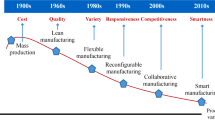Abstract
For several years, sensitive robots are used in industry and in some cases perform collaborative tasks directly with humans on shared workplaces. At first glance, this type of human-machine interaction is associated with high risks. However, additional devices, advanced functionalities and risk mitigation activities can ensure that such collaborative scenarios are safe for humans. The essential aspects are the collaborative operation methods, workspace layout, end effectors, human machine interfaces and ergonomics. In this work we shed light on these important aspects of human-robot collaboration and discuss its facets. By adequately reducing and communicate potential indiscernible risks a robot is made trustworthy for a human being.
Access this chapter
Tax calculation will be finalised at checkout
Purchases are for personal use only
Similar content being viewed by others
References
Christoffersen, K., Woods, D.D.: How to make automated systems team players. In: Advances in Human Performance and Cognitive Engineering Research, Chap. 1, vol. 2, pp. 1–12. Emerald Group Publishing Limited (2002)
DGUV: Collaborative robot systems - Design of systems with “Power and Force Limiting Function” function. Technical report FB HM-080 Issue 08/2017, Deutsche Gesetzliche Unfallversicherung (2017)
Endsley, M.: Toward a theory of situation awareness in dynamic systems. Hum. Factors J. Hum. Factors Ergonomics Soc. 37, 32–64 (1995)
Guiochet, J., Machin, M., Waeselynck, H.: Safety-critical advanced robots: a survey. Robot. Auton. Syst. 94, 43–52 (2017)
Haddadin, S., Albu-Schäffer, A., Hirzinger, G.: Soft-tissue injury in robotics. In: Proceedings of the 2010 IEEE International Conference on Robotics and Automation (2010)
Hirsch-Kreinsen, H.: Digitization of industrial work: development paths and prospects. J. Labour Market Res. 49, 1–14 (2016)
HVBG: Bypassing of protective devices on machinery. Technical report, Hauptverband der gewerblichen Berufsgenossenschaften (2006)
ISO: 10218–1:2011–07 Robots and robotic devices - Safety requirements for industrial robots - Part 1: Robots. Standard, International Organization for Standardization (2012)
ISO: 10218–2:2011–07 Robots and robotic devices - Safety requirements for industrial robots - Part 2: Robot systems and integration. Standard, International Organization for Standardization (2012)
ISO: 8373:2012–03 Robots and robotic devices - Vocabulary. Standard, International Organization for Standardization (2012)
ISO: 12100:2010–11 Safety of machinery - General principles for design - Risk assessment and risk reduction. Standard, International Organization for Standardization (2013)
ISO: CD 3691–4 Industrial trucks - Safety requirements and verification - Part 4: Driverless industrial trucks and their systems. Draft standard, International Organization for Standardization (2016)
ISO: TS 15066:2016 Robots and robotic devices - Collaborative robots. Technical specification, International Organization for Standardization (2016)
IVSS: Leitfaden für die Gefährdungsbeurteilung in Klein- und Mittelbetrieben - Manuelle Lastenhandhabung - Heben, Halten, Tragen, Ziehen, Schieben - Ermittlung und Bewertung von Gefährdungen; Festlegen von Manahmen. Technical report, Internationale Vereinigung für Soziale Sicherheit (2010)
Joseph, J., LaViola, J.: A discussion of cybersickness in virtual environments. ACM SIGCHI Bull. 32, 47–56 (2000)
Kuehn, J., Haddadin, S.: An artificial robot nervous system to teach robots how to feel pain and reflexively react to potentially damaging contacts. IEEE Robot. Autom. Lett. 2(1), 72–79 (2017)
Lacevic, B., Rocco, P.: Kinetostatic danger field - a novel safety assessment for human-robot interaction. In: 2010 IEEE/RSJ, International Conference on Intelligent Robots and Systems (IROS), Taipei, Taiwan, pp. 2169–2174 (2010)
Michalos, G., Makris, S., Tsarouchi, P., Guasch, T., Kontovrakis, D., Chryssolouris, G.: Design considerations for safe human-robot collaborative workplaces. Procedia CIRP 37, 248–253 (2015)
Peissner, M., Hipp, C.: Potenziale der Mensch-Technik Interaktion für die effiziente und vernetzte Produktion von Morgen. Technical report, Fraunhofer IAO (2013)
Vogel, C., Walter, C., Elkmann, N.: Safeguarding and supporting future human-robot cooperative manufacturing processes by a projection- and camera-based technology. In: 27th International Conference on Flexible Automation and Intelligent Manufacturing. FAIM 2017, Modena, Italy, pp. 39–46 (2017)
Werner, J.K., Salimian, A.C., Bollinger, R.S., Gordon, R.P., Swenson, K.A.: Safety device for a mechanical motion device, 3 May 2015. https://patents.google.com/patent/EP3265275A1/en, US20160257005A1
Wurhofer, D., Meneweger, T., Fuchsberger, V., Tscheligi, M.: Reflections on operators and maintenance engineers experiences of smart factories. In: Proceedings of the 2018 ACM Conference on Supporting Groupwork, pp. 284–296 (2018)
Acknowledgment
The results incorporated in this paper were gained within the scope of the project “HRC-Safety for employees” commissioned by the Allgemeine Unfallversicherungsanstalt (AUVA).
Author information
Authors and Affiliations
Corresponding author
Editor information
Editors and Affiliations
Rights and permissions
Copyright information
© 2018 Springer Nature Switzerland AG
About this paper
Cite this paper
Kaiser, L., Schlotzhauer, A., Brandstötter, M. (2018). Safety-Related Risks and Opportunities of Key Design-Aspects for Industrial Human-Robot Collaboration. In: Ronzhin, A., Rigoll, G., Meshcheryakov, R. (eds) Interactive Collaborative Robotics. ICR 2018. Lecture Notes in Computer Science(), vol 11097. Springer, Cham. https://doi.org/10.1007/978-3-319-99582-3_11
Download citation
DOI: https://doi.org/10.1007/978-3-319-99582-3_11
Published:
Publisher Name: Springer, Cham
Print ISBN: 978-3-319-99581-6
Online ISBN: 978-3-319-99582-3
eBook Packages: Computer ScienceComputer Science (R0)




